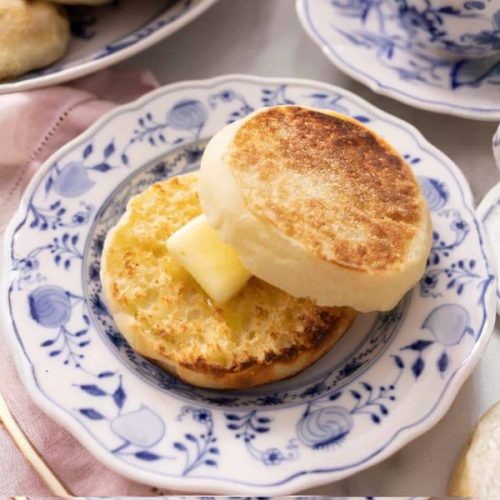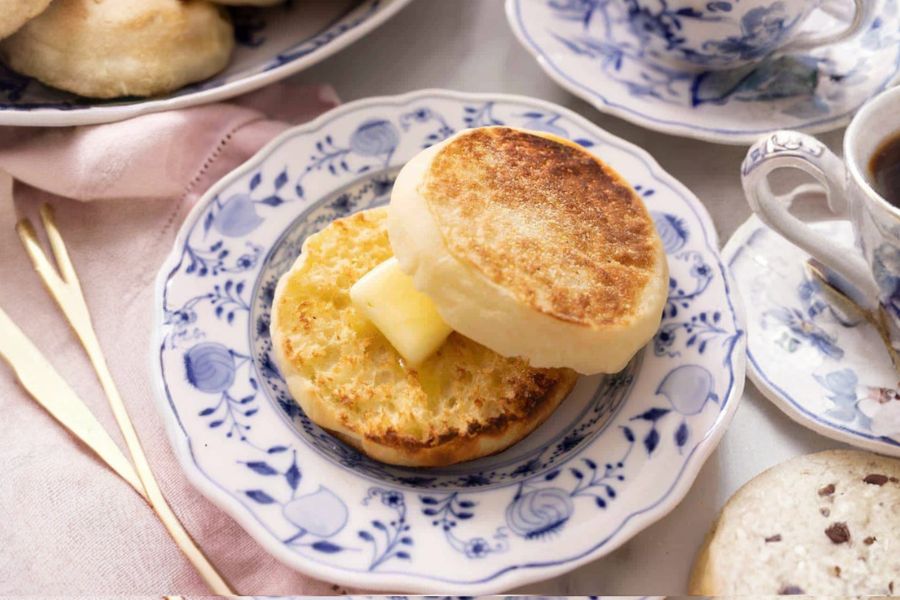These homemade English muffins are a delightfully soft yet slightly chewy breakfast classic, perfect for sandwiches or simply toasted with butter and jam.
What sets this recipe apart is its balance of ease and authentic texture: the muffins develop signature nooks and crannies without requiring complex techniques or long kneading.
Nutritionally, they are a moderate-carb, low-fat option that provides 4 grams of protein per muffin, offering a satisfying start to the day.
The use of milk, eggs, and a touch of butter adds good-quality fats and enhances flavor without overpowering the light crumb.
These muffins are versatile for everyday cooking—they are straightforward enough for a weekday breakfast yet impressive for brunch or meal prep.

You can make a batch in advance, refrigerate or freeze them, and enjoy a fresh, warm muffin anytime.
Must-Have Tools for Perfect Results
Stand Mixer with Paddle Attachment
Effortlessly mixes the sticky dough to a smooth, elastic consistency, saving time and preventing messy hands. Perfect for any bread, pastry, or cookie dough.
Large Skillet or Cast-Iron Griddle
Provides even, gentle heat to cook the muffins to golden perfection with those iconic nooks and crannies. A versatile tool for pancakes, searing, and stovetop breads.
3-Inch Round Cutter
Ensures uniform muffin shapes for even cooking and professional presentation. Useful for biscuits, cookies, and other shaped baked goods.
Parchment Paper
Prevents sticking and makes transferring muffins simple, reducing cleanup time. Essential for baking delicate items or roasting vegetables.
Measuring Cups and Spoons
Provides precise measurement of flour, liquids, and sugar to ensure consistent texture and flavor every time. An indispensable tool for all baking.

Fluffy English Muffins
Equipment
- 1 Stand mixer with paddle attachment
- 1 3-inch round cutter
- 2 Baking sheets lined with parchment paper
- 1 Measuring cup and spoons set
Ingredients
- 2 3/4 cups 330 g all-purpose flour
- 2 1/4 tsp instant yeast 1 package
- 1 tsp salt
- 2 tbsp sugar
- 3/4 cup 180 ml milk
- 1/2 cup 120 ml water
- 3 tbsp 42 g butter, melted
- 1 large egg room temperature
- Cornmeal or semolina for dusting
Instructions
- Activate the Yeast: In a medium-sized bowl or glass measuring cup, combine the milk, water, and sugar, then gently warm the mixture to around 110°F (43°C) in the microwave or on the stovetop until it is pleasantly warm but not hot. Sprinkle in the instant yeast and stir once to incorporate, then let it rest for 5–7 minutes until the mixture becomes foamy and aromatic, signaling that the yeast is active and ready for the dough.
- Prepare the Dry Ingredients: While the yeast is activating, measure out the flour and salt into the bowl of a stand mixer fitted with a paddle attachment, then whisk them together to ensure even distribution. This step ensures that the salt and flour are well combined, which promotes uniform dough texture and prevents pockets of dry ingredients in the muffins.
- Combine Wet Ingredients: In a separate small bowl, whisk together the egg and melted butter until smooth, then gradually add this mixture to the foamy milk and yeast blend. Slowly pour the liquid into the flour mixture while the stand mixer runs on low speed, allowing the ingredients to come together gradually and form a cohesive dough.
- Knead the Dough: Increase the mixer speed to medium-high and knead the dough for about 7 minutes, or until it becomes smooth, elastic, and slightly tacky to the touch. Proper kneading develops gluten, which creates the signature airy texture and chewy structure of English muffins.
- First Proof: Transfer the dough to a large, lightly oiled bowl and cover it with plastic wrap or a damp towel, then set it in a warm, draft-free area to rise until doubled in size, about 1 hour. For enhanced flavor, you can refrigerate the dough overnight, then allow it to warm at room temperature for about an hour before proceeding.
- Shape the Muffins: Turn the risen dough onto a lightly floured surface and gently pat it into a rectangle just under 1 inch thick. Sprinkle two parchment-lined baking sheets with cornmeal or semolina, then use a 3-inch round cutter to cut the dough into uniform rounds, transferring each carefully to the prepared sheets. Cover loosely and allow the shaped muffins to rise for an additional 30 minutes.
- Cook the Muffins: Heat a large skillet or cast-iron griddle over very low heat until it is warm to the touch, then lightly sprinkle cornmeal on the surface. Place 3–4 muffins in the pan, cover with a lid, and cook for 5–6 minutes per side, checking that the bottom is golden brown before flipping. Continue with remaining muffins, adding fresh cornmeal to the pan as needed to prevent sticking.
- Cool and Serve: Transfer the cooked muffins to a wire rack and allow them to cool slightly before slicing with a serrated knife. Enjoy warm, toasted, or as a base for breakfast sandwiches, storing any leftovers in an airtight container for 3–5 days or freezing for up to 3 months.
Notes
- Allowing the dough to proof longer (4–8 hours) develops deeper, more complex flavors.
- Using a stand mixer is recommended since the dough is sticky and can be difficult to knead by hand.
- For a chewier texture, substitute bread flour for all-purpose flour.
- Keep the dough in a warm, draft-free spot; avoid direct sunlight or high heat, which can hinder rising.
- If a round cutter isn’t available, shape muffins by hand for rustic charm.
- Under-baked muffins can be corrected by finishing in a 350°F oven for 3 minutes.
- Lightly brushing the pan with butter prevents sticking during cooking.
- A cast-iron skillet or griddle yields the best browning and consistent heat.
- Brush away excess semolina between batches to avoid burning.
- English muffins taste best toasted and sliced with a serrated knife.
Chef’s Secrets For Perfect Muffins
Achieving the ideal English muffin texture relies on patient proofing and careful cooking.
Allow the dough to rise fully; this step ensures a light, airy interior and that signature nooks and crannies.
Gentle kneading develops gluten without overworking the dough, giving each muffin a slightly chewy bite while remaining tender.
Using semolina or cornmeal on your baking surface prevents sticking while adding a subtle, rustic crunch.
Cooking over very low heat ensures even browning without burning, producing that classic golden crust.
For extra flavor, refrigerate the dough overnight—this slow fermentation deepens the taste and enhances the muffin’s aroma.
Serving Suggestions For Daily Enjoyment
English muffins are incredibly versatile and pair well with both sweet and savory toppings.
Split and toast them lightly, then spread with butter, jam, or honey for a quick breakfast treat.
They also make the perfect foundation for breakfast sandwiches with eggs, avocado, and cheese.
For a savory twist, try topping with smoked salmon, cream cheese, and fresh herbs.
Their airy structure absorbs spreads beautifully while holding up to hearty fillings, making them ideal for meal prep and on-the-go breakfasts.
Storage Tips For Longevity
Cooked English muffins store well in an airtight container at room temperature for 3–5 days.
To keep them fresh longer, freeze individual muffins in a zip-top bag for up to 3 months.
Reheat frozen muffins directly in a toaster or oven for best results.
If storing unbaked dough in the fridge, allow it to come to room temperature and rise for about an hour before cooking.
Proper storage ensures that you always have fluffy, flavorful muffins ready for breakfast or snacks.
Frequently Asked Questions About Muffins
1. Can I use bread flour instead of all-purpose?
Yes, bread flour will give your muffins a chewier texture and slightly more structure, which some bakers prefer.
2. Why are my muffins flat?
Flat muffins usually result from under-proofing or over-mixing. Ensure the dough doubles in size during the first rise and handle gently when shaping.
3. How do I prevent sticking during cooking?
Use semolina or cornmeal on your skillet surface and consider lightly brushing with butter to keep muffins from adhering.
4. Can I refrigerate the dough overnight?
Absolutely. Slow refrigeration enhances flavor. Let the dough sit at room temperature for about an hour before cooking to reactivate the yeast.
5. How should I slice muffins for serving?
Always use a serrated knife. Cut gently along the middle to preserve the airy interior and maintain the muffin’s nooks and crannies.
This recipe has been adapted and simplified from the original version by preppykitchen. We’ve refined the steps for a smoother cooking experience and added helpful notes, nutrition insights, and essential kitchen tools to make it even easier for home cooks.

